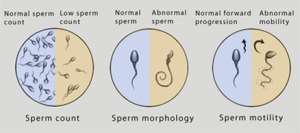
Potential cases of male infertility will be assessed as part of a thorough physical examination of the penis, scrotum and prostate as well as medical history regarding potential contributing factors. Several tests may be conducted to assess ones fertility. One of which is the Semen analysis. It may be conducted to determine the number and quality of sperm. In addition, a blood test to check for infections or hormone problems may equally be conducted to rule out hormonal problems. Furthermore, a culture of fluid from the penis can be done to check for infections.
Howbeit, Semen analysis remains the gold standard for male fertility testing. When semen analysis is done, your health care provider will be looking for some specific markers to access fertility. These includes;
1.Total amount or volume of semen (2 milliliters is considered normal. A lower amount may indicate an issue with the seminal vesicles, blocked ducts or a prostate gland issue),
2.Sperm count (20 million to 300 million per milliliter is considered in the normal range for sperm counts. Below 10 million is considered “poor.”) ,
3.Morphology( the size and shape of the sperm affect the sperms ability to reach and fertilize an egg. 30% is considered a good amount of sperm that are shaped “normal.”),
4.Motility (movement and number of active cells. Movement is rated from 0-4, with score over 3 considered good.
5.The amount of active cells is rated in percentages from 1-100%, with 50% considered the minimum.)
When the underlying cause of infertility is well established, an appropriate treatment regimen may be rolled out. These may include taking medications to help increase sperm production, taking antibiotics to heal an infection, taking hormones to improve hormone imbalance or non- pharmacological treatments such as wearing looser underwear (boxer shorts). In addition, clinically proven supplements may be recommended to improve Sperm production. Anything that increases the number of healthy sperm increases the chances of conception. However, Artificial insemination remains an option if the man’s sperm count is low. In this procedure, sperm is collected through multiple ejaculations. They are then manually placed in the female’s uterus or fallopian tubes. In addition, In vitro fertilization is another option that can be used to overcome male infertility factors. In this procedure, the sperm and egg are fertilized in a laboratory after which the fertilized egg is placed in the female’s uterus.
Howbeit if tests show that there is no sperm production or that other related problems are present, donor sperm can be used to help facilitate conception. In this procedure, donor sperm are obtained from a sperm bank and placed inside the female’s uterus or fallopian tubes through artificial insemination.
Some couples prefer to explore more traditional or alternative medicine options before exploring infertility procedures due to religious or personal reasons. However the onus is on the couple to find a suitable fertility plan when the need arises. I would advise that couples explore fertility remedies together instead of the usual excuse of pointing fingers at each other. It must be said that in Africa, women are blamed the most when years of intimacy in marriage does not result in pregnancy. However, the reality is that; 8 to 12 % of couples experience fertility problems worldwide out of which 50 percent of cases stem from factors that affect the man.
By Dr(MH) Ernest Aggrey, 0543999776/[email protected]




 We’ll protect state wealth from opaque deals – Prof Jane Naana
We’ll protect state wealth from opaque deals – Prof Jane Naana
 Mauritania president says running for second term in June polls
Mauritania president says running for second term in June polls
 I won't ever say I was a mere driver’s mate' — Prof. Opoku-Agyemang
I won't ever say I was a mere driver’s mate' — Prof. Opoku-Agyemang
 2024 polls: 'EC struggling to defend credibility'— Prof. Opoku-Agyemang
2024 polls: 'EC struggling to defend credibility'— Prof. Opoku-Agyemang
 Akufo-Addo gov't's 'greed, unbridled arrogance, unrestrained impunity, sheer dis...
Akufo-Addo gov't's 'greed, unbridled arrogance, unrestrained impunity, sheer dis...
 Election 2024: Ghana needs an urgent reset, a leadership that is inspiring – Ma...
Election 2024: Ghana needs an urgent reset, a leadership that is inspiring – Ma...
 Partner NDC to rollout a future of limitless prospects – Prof Jane Naana Opoku-A...
Partner NDC to rollout a future of limitless prospects – Prof Jane Naana Opoku-A...
 NPP will remain in gov’t till Jesus comes — Diana Asamoah
NPP will remain in gov’t till Jesus comes — Diana Asamoah
 Sunyani Technical University demands apology from former SRC president over sex-...
Sunyani Technical University demands apology from former SRC president over sex-...
 'Dumsor' was resolved by Mahama but ‘incompetent' Akufo-Addo has destroyed the g...
'Dumsor' was resolved by Mahama but ‘incompetent' Akufo-Addo has destroyed the g...
